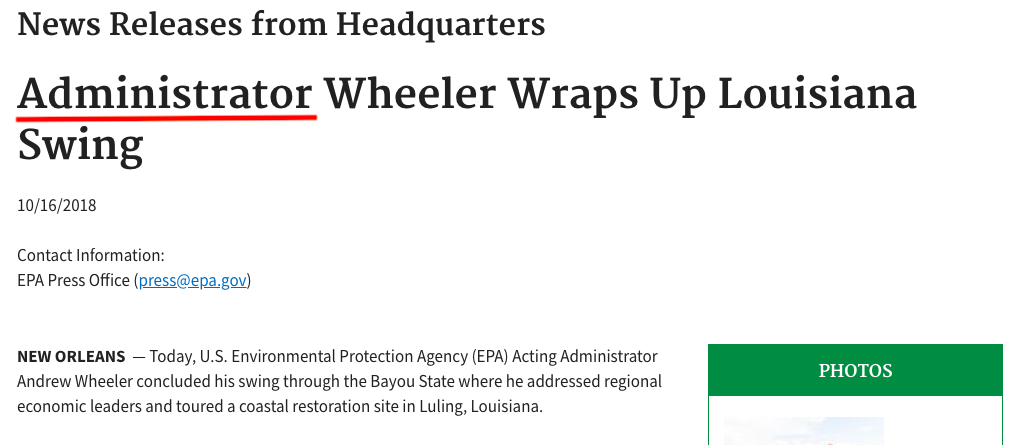

Andrew Wheeler, the acting administrator of the U.S. Environmental Protection Agency (EPA), might continue to oversee the office without Senate confirmation until President Trump‘s term is over, according to reports from Bloomberg and the Huffington Post.
The
former coal lobbyist has been the temporary EPA boss for more than 100 days ever since his predecessor Scott Pruitt resigned in July after a long list of ethics scandals.
Wheeler—as he moves to disband a scientific panel that reviews air pollutants and drafts a plan to allow coal plants to emit more toxic mercury—has yet to be formally nominated by President Trump, who likely wants to avoid a contentious confirmation process.
Bloomberg explained:
The duration of Wheeler’s time at EPA’s helm depends on whether Trump nominates someone else as EPA chief in his stead. But Wheeler could serve as acting administrator for years under the 1998 federal vacancies law, with virtually no legal limitations on his power to lead the EPA, said
Anne Joseph O’Connell, a professor of law at Stanford University.“Formally, these acting officials have the full authority of the position,” she said. “Functionally, there is a debate, because they don’t have the stature” of fully confirmed leaders, and may lack the authority, guaranteed tenure and gravitas to effect big change.
Wheeler has already served the fifth-longest tenure as an acting EPA head, according to HuffPost.
HuffPost also noticed that on Wednesday—Wheeler’s 100th day in the position—an EPA news release about his visit to Louisiana changed his title from “acting administrator” to “administrator” in the subject line.
Screenshot of Oct. 16 EPA news release. Red underline added by EcoWatch
The title change could have been a mistake but the EPA declined to comment on the record to reporter Alexander C. Kaufman. The office later issued a press release with the title “acting administrator” in the subject line, HuffPost reported.
https://twitter.com/aterkel/statuses/1052660909775163392 caption=”” photo_credit_src=”https://twitter.com/aterkel/status/1052660909775163392″ photo_credit=””
In response to the reports, the
Sierra Club noted that the Federal Vacancies Reform Act of 1998 says an acting administration official may serve “no longer than 210 days beginning on the date the vacancy occurs.”
“Regardless of what he may believe, Andrew Wheeler cannot rewrite the Vacancies Act just as he cannot disregard bedrock environmental laws to give free reign to the corporate polluters he once and seemingly still believes he works for,” Sierra Club legislative director Melinda Pierce said in a
press release. “With a toxic record of attacking public health and clean air and water in his 100 days as acting Administrator, Wheeler has proven he’s not fit for the job, and certainly not deserving of the permanent title.”
https://twitter.com/foe_us/statuses/1051906818316935169 caption=”” photo_credit_src=”https://twitter.com/foe_us/status/1051906818316935169″ photo_credit=””

 233k
233k  41k
41k  Subscribe
Subscribe 
